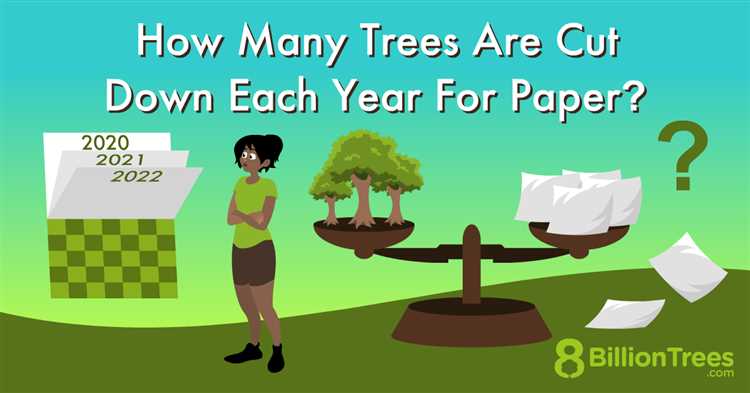
When we use paper every day, we rarely stop to think about where it came from or how it was made. However, the process of turning trees into paper is not as simple as it may seem. It takes a significant number of trees to produce just a small amount of paper.
To find out how many trees it takes to make 10,000 pieces of paper, we need to consider several factors. First, we need to know the average number of sheets of paper that can be made from a single tree. This can vary depending on the type and size of the tree, as well as the quality of the paper being produced.
Second, we need to take into account the efficiency of the paper-making process. Not all parts of a tree can be used to make paper, and some waste is generated during the manufacturing process. This means that the actual number of trees required to produce 10,000 pieces of paper will be higher than the calculated number based on the average number of sheets per tree.
While it is difficult to provide an exact answer without specific information about the type of paper and the paper-making process, it is safe to say that a significant number of trees are required. The production of paper has a considerable impact on our environment, as it contributes to deforestation and the destruction of natural habitats. Therefore, it is essential for us to reduce our paper consumption and seek out more sustainable alternatives.
- Importance of Paper Recycling
- Tree consumption for 10,000 sheets of paper
- Environmental impact of paper production
- Deforestation and habitat loss
- Pollution and climate change
- Sustainable paper production methods
- The role of paper consumption in deforestation
- The paper production process
- The impact of paper consumption on forests
- Alternatives to traditional paper products
- 1. Recycled paper
- 2. Digitalization
- Q&A:
- How many trees are needed to produce 10000 pieces of paper?
- Which type of trees are commonly used in paper production?
- How much paper can be produced from one tree?
- Is paper production harming the environment?
- Are there any alternative materials to paper that can be used instead?
- How many trees are needed to produce 10000 pieces of paper?
- What is the process of making paper from trees?
Importance of Paper Recycling
Paper recycling is a crucial practice that plays a significant role in conserving our natural resources and protecting the environment. By recycling paper, we can reduce the need for new paper production, which requires cutting down trees and consuming large amounts of energy and water.
One of the key benefits of paper recycling is the preservation of forests. Every ton of recycled paper saves approximately 17 trees from being cut down. By recycling 10,000 pieces of paper, we can save a significant number of trees, helping to maintain essential habitats for wildlife and preserving biodiversity.
Furthermore, paper recycling plays a vital role in reducing greenhouse gas emissions. The production of paper from virgin materials results in the release of carbon dioxide and other harmful pollutants into the atmosphere. By recycling paper, we can significantly decrease these emissions, helping to combat climate change and improve air quality.
Moreover, paper recycling conserves water resources. The recycling process requires much less water compared to the production of paper from virgin materials. By recycling 10,000 pieces of paper, we can save approximately 60,000 liters of water, contributing to the conservation of this precious resource.
Additionally, paper recycling helps to save energy. The manufacturing process of paper from recycled materials consumes less energy compared to producing paper from virgin materials. By recycling paper, we can reduce the energy demand, decrease reliance on fossil fuels, and mitigate the environmental impact of energy production.
Lastly, paper recycling contributes to the circular economy. By recycling paper, we can transform it into new paper products, reducing the need for raw materials and extending the life cycle of the paper. This circular approach fosters a sustainable and resource-efficient society, promoting environmental and economic benefits.
In conclusion, paper recycling is of utmost importance for the preservation of natural resources, the protection of the environment, and the promotion of sustainable practices. By actively participating in paper recycling, we can make a significant impact in conserving our forests, reducing greenhouse gas emissions, conserving water, saving energy, and fostering a circular economy.
Tree consumption for 10,000 sheets of paper
It is estimated that it takes approximately 20 trees to produce 10,000 sheets of paper.
Each tree can yield about 500 sheets of paper, depending on the size and quality of the trees used. This number may vary slightly depending on the specific type of paper being produced.
One way to reduce the number of trees consumed is by promoting sustainable forestry practices and using recycled paper. Recycling paper can help reduce the demand for virgin trees and lessen the environmental impact of paper production.
In addition to the trees themselves, the paper production process also requires energy, water, and chemicals. These resources must be carefully managed to minimize the environmental impact of paper manufacturing.
As consumers, we can also play a role in reducing tree consumption by using paper products responsibly and considering alternatives such as electronic documentation or digital communication when possible.
- Choose recycled paper products when available.
- Print double-sided whenever possible.
- Reuse paper for scrap or note-taking purposes.
- Opt for digital receipts and documents instead of printed copies.
- Share information electronically rather than printing and mailing physical copies.
By being mindful of our paper consumption and actively seeking ways to reduce it, we can help protect our forests and minimize the environmental impact of paper production.
Environmental impact of paper production
Paper production has a significant impact on the environment, particularly due to the number of trees that need to be harvested to meet the demand for paper products. The global paper industry relies heavily on wood as its primary raw material, leading to massive deforestation in many parts of the world.
The process of converting wood into paper involves several stages, each of which has its own environmental impact. First, trees are logged and transported to pulp mills, where they are chipped, cooked, and washed to remove impurities. This process requires a significant amount of water and energy, contributing to water pollution and greenhouse gas emissions.
In addition to deforestation and pollution, paper production also generates significant amounts of waste. The production of paper results in a considerable amount of sludge and waste water that contains chemicals used in the pulping process. Proper treatment and disposal of these wastes are crucial to prevent further environmental damage.
Deforestation and habitat loss
The demand for paper leads to the clearance of forests, which not only removes carbon sinks but also destroys habitats for countless plant and animal species. Deforestation disrupts ecosystems and reduces biodiversity, leading to negative impacts on the overall health of the planet.
Pollution and climate change
The paper industry is a significant source of greenhouse gas emissions, primarily due to the energy-intensive processes involved in pulp and paper production. Additionally, the chemicals used in bleaching and pulping contribute to air and water pollution, which can have adverse effects on local ecosystems and human health.
The environmental impact of paper production extends beyond the direct consequences of the industry itself. The demand for paper also drives the establishment of plantations, which often replace diverse natural forests and disrupt local ecosystems even further.
In conclusion, the production of paper has a profound and wide-ranging environmental impact. It contributes to deforestation, habitat loss, pollution, and climate change. To mitigate these effects, it is essential to promote sustainable paper production practices, such as recycling, using alternative fibers, and reducing paper consumption overall.
Sustainable paper production methods
Paper production has a significant impact on the environment due to the large amount of trees required to make it. However, with the increasing focus on sustainability, there have been several methods developed to make paper production more environmentally friendly.
One sustainable method is the use of recycled paper. By using recycled paper as a raw material, fewer trees need to be cut down, reducing deforestation and preserving natural habitats. Additionally, recycling paper reduces the demand for energy and water needed in the production process.
Another sustainable method is the use of alternative fibers. Instead of relying solely on trees, paper can be made from agricultural residues, such as wheat straw or sugarcane bagasse. These alternative fibers not only reduce the pressure on forests but also provide an additional source of income for farmers.
Furthermore, sustainable paper production methods focus on minimizing waste and emissions. By implementing efficient manufacturing processes and utilizing renewable energy sources, paper mills can reduce their carbon footprint and contribute to a cleaner environment.
Another approach is adopting responsible forestry practices. This includes practicing selective logging, where only mature trees are harvested, and replanting trees to ensure a continuous supply of wood. Forest certification systems, such as the Forest Stewardship Council (FSC), help monitor and promote sustainable forestry practices.
In conclusion, sustainable paper production methods aim to minimize the environmental impact of paper production by utilizing recycled paper, alternative fibers, efficient manufacturing processes, renewable energy sources, and responsible forestry practices. By adopting these methods, we can make paper production more sustainable and help protect our natural resources.
The role of paper consumption in deforestation
Paper consumption is a significant driver of deforestation worldwide. The demand for paper products, such as books, newspapers, and packaging, continues to increase, leading to the clearance of vast areas of forests.
Deforestation is the process of clearing forests or trees from land, typically to convert the land into non-forest use. The impact of deforestation is devastating, as it disrupts ecosystems, contributes to climate change, and threatens the habitats of numerous plant and animal species.
Paper consumption is a major contributor to deforestation due to the reliance on trees as the primary raw material for paper production.
The paper production process
The paper production process involves several stages, starting with the harvesting of trees. Trees are cut down, transported to mills, and then converted into wood pulp. The wood pulp is further processed and transformed into sheets of paper.
Each stage of paper production requires a significant amount of energy, water, and chemicals, further adding to the environmental impact.
The impact of paper consumption on forests
As the demand for paper products continues to rise, more trees need to be cut down to meet this demand. This puts immense pressure on forests, especially old-growth forests that have high ecological value.
The loss of forests due to paper consumption not only results in the destruction of wildlife habitats but also contributes to climate change. Forests act as carbon sinks, absorbing carbon dioxide from the atmosphere. When trees are cut down, this carbon dioxide is released back into the atmosphere, exacerbating the greenhouse effect.
Additionally, the destruction of forests disrupts water cycles, leading to soil erosion and the loss of biodiversity.
To mitigate the impact of paper consumption on deforestation, it is crucial to promote sustainable practices. This includes reducing paper waste, recycling paper products, and using alternative materials when feasible. Additionally, supporting organizations that engage in reforestation efforts and the preservation of existing forests can help combat deforestation caused by paper consumption.
Alternatives to traditional paper products

Paper is an essential part of our daily lives, but it can also have a negative impact on the environment. The production of paper involves cutting down trees and consumes large amounts of energy and water. However, there are alternatives to traditional paper products that are more sustainable and eco-friendly.
1. Recycled paper
One alternative is to use recycled paper. This type of paper is made from used paper products, such as newspapers, magazines, and office paper, that are collected, sorted, and processed into new paper. By using recycled paper, we can reduce the demand for virgin wood pulp and save valuable natural resources.
2. Digitalization

In today’s digital age, we have the option to go paperless by using electronic devices to store and exchange information. This includes using email instead of sending letters, reading e-books instead of printed books, and storing documents digitally rather than printing them out. Digitalization not only saves paper but also reduces the need for transportation and storage, making it a more environmentally friendly option.
However, it is important to consider the environmental impact of electronic devices and their production. Electronic devices are made using various materials, including metals, plastics, and rare earth minerals, which require mining, processing, and manufacturing. Additionally, the disposal of electronic waste can be harmful if not managed properly. Therefore, while digitalization reduces paper waste, it is essential to recycle and dispose of electronic devices responsibly.
While these alternatives offer more sustainable options compared to traditional paper products, it’s important to remember that reducing paper consumption overall is also key to minimizing environmental impact.
Q&A:
How many trees are needed to produce 10000 pieces of paper?
It depends on the type of trees and the size of the trees. On average, it takes about 1.5 trees to make 10000 pieces of paper.
Which type of trees are commonly used in paper production?
Common trees used in paper production include spruce, pine, fir, eucalyptus, and birch.
How much paper can be produced from one tree?
On average, one tree can produce about 8,333 sheets of paper.
Is paper production harming the environment?
Yes, paper production can have negative environmental impacts, especially when forests are not properly managed and deforestation occurs.
Are there any alternative materials to paper that can be used instead?
Yes, there are alternatives to traditional paper such as recycled paper, bamboo paper, and various types of synthetic paper.
How many trees are needed to produce 10000 pieces of paper?
On average, it takes about 24 trees to produce 10000 pieces of paper.
What is the process of making paper from trees?
The process of making paper from trees involves several steps. First, the trees are cut down and transported to a paper mill. Then, the trees are debarked and chipped into small pieces. These wood chips are then pulped, which involves breaking them down into fibers. The pulp is then cleaned, bleached, and mixed with water to form a slurry. The slurry is then spread onto a wire mesh and passed through a series of rollers to remove water. Finally, the paper is dried and rolled into large rolls, which can then be cut into smaller pieces.